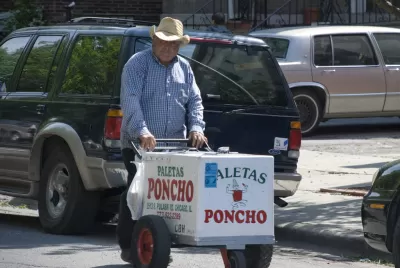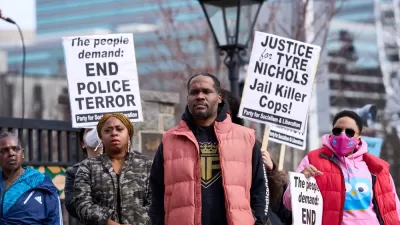While recent crackdowns on street vending suggest it is a problem to be fixed, the reality is that street vendors energize urban spaces and make them more accessible for everyone.

Alissa Walker makes the case that street vendors contribute to public spaces in important ways. "In places where city leaders have made very little effort to improve the experience for those walking, biking, or riding transit, it’s the people selling goods or serving food in those same spaces who make streets vibrant, welcoming, and safe for all."
She says that the role of vendors is most evident in the most neglected parts of cities, which feel unsafe without the presence of people. "Waiting for the bus alone at night, at a poorly lit corner in front of a vacant building, just hearing the scrape of plastic stools at the taco stand posted up outside a nearby auto body shop is comforting. I can confidently say I feel safer because people are prepping, cooking, and devouring al pastor on my sidewalk," says Walker.
Street vendors are not criminals, argues Walker, and the recent handcuffing of a churro vendor in a New York City subway station is an example of unnecessary policing of urban spaces. The arguments against street vending, that vendors pose a danger or block sidewalks, are not valid, she says. "When law enforcement officials see a churro cart as an obstacle, they likely don’t understand the value that a churro cart provides to the rest of us."
FULL STORY: Why street vendors make cities feel safer

Maui's Vacation Rental Debate Turns Ugly
Verbal attacks, misinformation campaigns and fistfights plague a high-stakes debate to convert thousands of vacation rentals into long-term housing.

Planetizen Federal Action Tracker
A weekly monitor of how Trump’s orders and actions are impacting planners and planning in America.

In Urban Planning, AI Prompting Could be the New Design Thinking
Creativity has long been key to great urban design. What if we see AI as our new creative partner?

King County Supportive Housing Program Offers Hope for Unhoused Residents
The county is taking a ‘Housing First’ approach that prioritizes getting people into housing, then offering wraparound supportive services.

Researchers Use AI to Get Clearer Picture of US Housing
Analysts are using artificial intelligence to supercharge their research by allowing them to comb through data faster. Though these AI tools can be error prone, they save time and housing researchers are optimistic about the future.

Making Shared Micromobility More Inclusive
Cities and shared mobility system operators can do more to include people with disabilities in planning and operations, per a new report.
Urban Design for Planners 1: Software Tools
This six-course series explores essential urban design concepts using open source software and equips planners with the tools they need to participate fully in the urban design process.
Planning for Universal Design
Learn the tools for implementing Universal Design in planning regulations.
planning NEXT
Appalachian Highlands Housing Partners
Mpact (founded as Rail~Volution)
City of Camden Redevelopment Agency
City of Astoria
City of Portland
City of Laramie





























